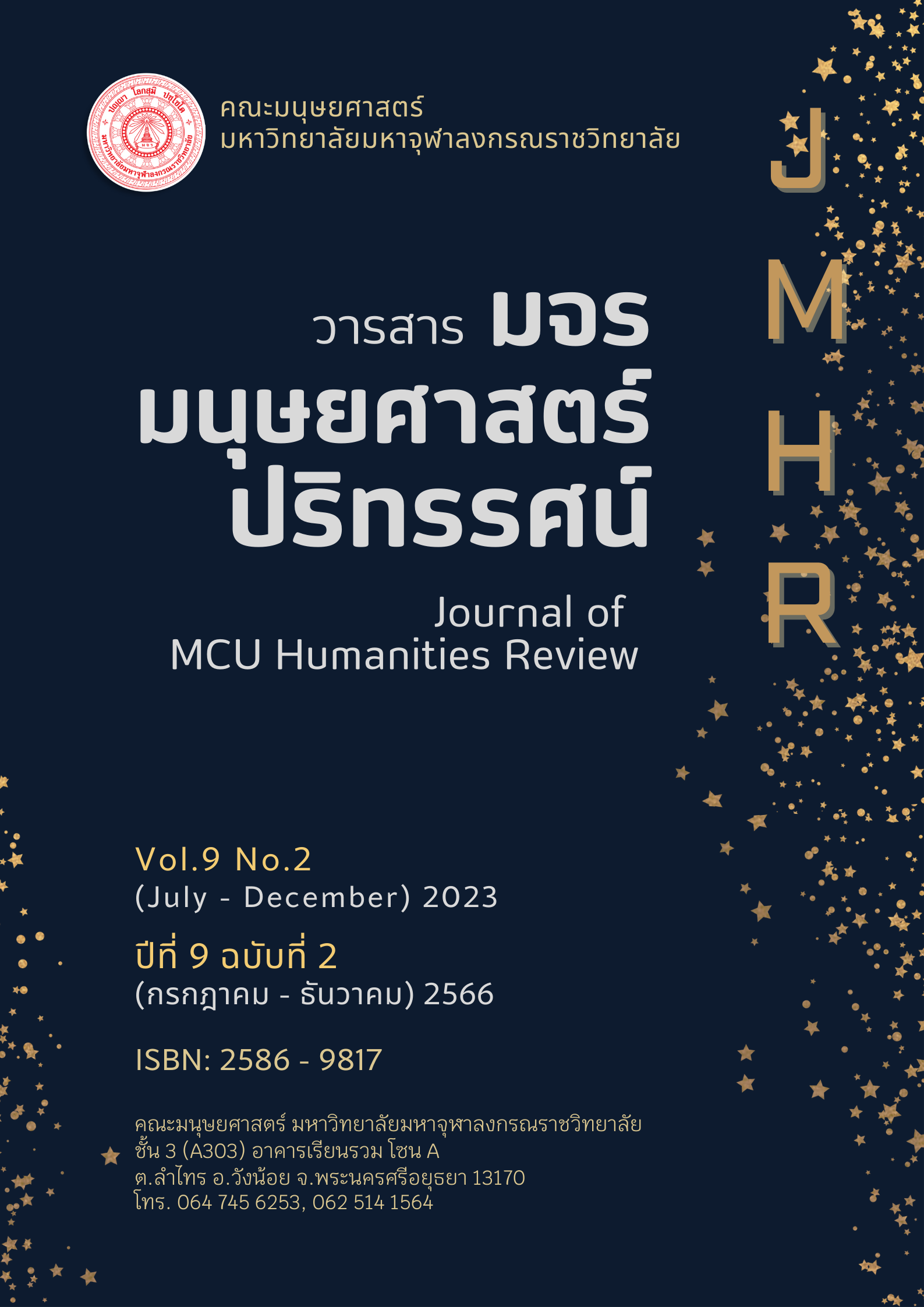รูปแบบการสื่อสารเพื่อความสำเร็จของบุคคลวัยทำงานตามแนวพุทธจิตวิทยา
คำสำคัญ:
รูปแบบการสื่อสาร, ความสำเร็จ, วัยทำงาน, พุทธจิตวิทยาบทคัดย่อ
การวิจัยเรื่องรูปแบบการสื่อสารเพื่อความสำเร็จของบุคคลวัยทำงานตามแนวพุทธจิตวิทยา มีวัตถุประสงค์ 1. เพื่อศึกษาแนวคิดและทฤษฎีการสื่อสารเพื่อความสำเร็จของบุคคลวัยทำงานตามแนวพุทธจิตวิทยา 2. เพื่อวิเคราะห์และสังเคราะห์หลักพุทธธรรมและหลักจิตวิทยาในการสร้างรูปแบบการสื่อสารเพื่อความสำเร็จของบุคคลวัยทำงานตามแนวพุทธจิตวิทยา 3. เพื่อนำเสนอรูปแบบการสื่อสารเพื่อความสำเร็จของบุคคลวัยทำงานตามแนวพุทธจิตวิทยา เป็นการวิจัยเชิงคุณภาพ ผู้วิจัยใช้วิธีการสัมภาษณ์เชิงลึกกับผู้ให้ข้อมูลสำคัญ โดยใช้แบบสัมภาษณ์กึ่งโครงสร้าง บุคคลทำงานอาชีพต่าง ๆ จำนวน 15 คน และสัมภาษณ์เชิงลึกผู้เชี่ยวชาญ 3 กลุ่ม จำนวน 9 คน การสนทนากลุ่มโดยผู้เชี่ยวชาญ 3 กลุ่ม จำนวน 9 คน เพื่อตรวจสอบรูปแบบการสื่อสารเพื่อความสำเร็จของบุคคลวัยทำงานตามแนวพุทธจิตวิทยา รวมทั้งสิ้น 27 คน แล้ววิเคราะห์เนื้อหา ด้วยเทคนิค 6C
ผลการวิจัยพบว่า
- แนวคิดและทฤษฎีการสื่อสารเพื่อความสำเร็จของบุคคลวัยทำงานตามแนวพุทธจิตวิทยามีองค์ประกอบที่สำคัญ 3 ประการ คือ 1) ด้านผู้ส่งสาร ควรมีคุณสมบัติ คือคิดก่อนพูด แล้วพูดด้วยความจริง พูดด้วยอิงประโยชน์ กระทบโสตด้วยความนุ่มนวล ชวนให้เกิดปัญญา มีทีท่าที่สุขุม คิดเพิ่มพูนกัลยาณมิตร จิตประกอบด้วยเมตตา ศรัทธาแรงกล้าเพื่อเป้าประสงค์ เจาะจง ชัดเจน พร้อมถูกกาลและเข้าใจความแตกต่างของบุคคล 2) ด้านสาร ที่ส่งออกไปต้องมีคุณลักษณะ 5 ประการ คือ สัจจะ ต้องเป็นเรื่องจริง ตถตา สารนั้นต้องจริงแท้ กาละ เหมาะสมกับเวลา ปิยะ ความชอบใจ พอใจ สารอันเป็นที่รักของผู้ส่งสารและผู้รับสาร และสารนั้นประกอบด้วยอัตถะ ความเป็นประโยชน์ 3) ด้านผู้รับสาร ต้องประกอบด้วยคุณสมบัติ คือ ฟังด้วยสติ พิจารณาข้อมูล ปราศจากอคติ มีท่าทีที่สุภาพ ทราบเทคนิคการสนทนา ด้วยวาจาที่นอบน้อม พร้อมใส่ใจคนส่งสาร คิดสร้างสรรค์สัมพันธภาพที่ดีด้วยวจีที่จริงใจ ใช้อารมณ์ให้สุนทรีย์ ประกอบกับมีมารยาทที่น่าชื่นชม
- การวิเคราะห์และสังเคราะห์หลักธรรมและหลักจิตวิทยาเพื่อสร้างรูปแบบการสื่อสารเพื่อความสำเร็จของบุคคลวัยทำงานตามแนวพุทธจิตวิทยาประกอบด้วย การวิเคราะห์ ได้แก่ 1) หลักธรรม ได้แก่ หลักอิทธิบาท 4 สังคหวัตถุ 4 หลักวาจาสุภาษิต และหลักสัปปุริสธรรม 7 2) หลักจิตวิทยา ได้แก่หลักการวิเคราะห์การสื่อสารระหว่างบุคคลของอีริค เบิร์นและแรงจูงใจใฝ่สัมฤทธิ์ของแมคเคลแลนด์ และการสังเคราะห์ออกมาเป็นรูปแบบชื่อว่า “KWASDHR MODEL”
- รูปแบบการสื่อสารเพื่อความสำเร็จของบุคคลวัยทำงานตามแนวพุทธจิตวิทยาเป็นรูปแบบที่ให้ความสำคัญกับองค์ประกอบการสื่อสาร 3 ด้าน คือ ด้านผู้ส่งสาร ด้านสารและด้านผู้รับสาร หลักพุทธธรรมและหลักจิตวิทยาที่นำมามีความเหมาะสม ประกอบด้วยมาตรฐาน 4 ด้าน คือ ด้านความเป็นประโยชน์ มาตรฐานความเป็นไปได้ มาตรฐานความเหมาะสมและมาตรฐานความถูกต้อง เรียกว่า “KWASDHR MODEL” ประกอบด้วย 1) องค์ความรู้ 2) ปัญญา 3) การตระหนักรู้ 4) คุณค่าในตนเอง 5) การพัฒนา 6) ความสุข 7) ความสัมพันธ์ที่ประเสริฐ เมื่อนำรูปแบบไปใช้จะเกิดความสำเร็จในชีวิตของบุคคลวัยทำงาน ทั้งงานระดับปรมัตถ์ งานระบบสังคมตามฐานะความสัมพันธ์ และงานตามตำแหน่ง
เอกสารอ้างอิง
ทัศนีย์ เจนวิถีสุข. (2555). การสื่อสารเชิงพุทธกับการเปลี่ยนแปลงสังคม (วิทยานิพนธ์พุทธศาสตรดุษฎีบัณฑิต). มหาวิทยาลัยมหาจุฬาลงกรณราชวิทยาลัย. พระนครศรีอยุธยา.
นภัทร์ แก้วนาค. (2548). เทคนิคการวิเคราะห์ข้อมูลเชิงคุณภาพ. กรุงเทพฯ: อักษรวัฒนา.
“_________”. (2555). เอกสารการสอนวิชาระเบียบวิธีวิทยาการวิจัย. กรุงเทพฯ: โรงพิมพ์มหาจุฬาลงกรณราชวิทยาลัย.
พระครูปลัดอรรณพ ปญฺญาสาโร (ฟักสังข์). (2563). รูปแบบการสร้างเป้าหมายชีวิตเชิงพุทธจิตวิทยาของนักเรียนชั้นมัธยมศึกษาตอนปลาย กรุงเทพมหานคร (วิทยานิพนธ์พุทธศาสตรดุษฎีบัณฑิต). มหาวิทยาลัยมหาจุฬาลงกรณราชวิทยาลัย. พระนครศรีอยุธยา.
พระพรหมคุณาภรณ์ (ป.อ. ปยุตฺโต). (2550). คู่มือชีวิต (พิมพ์ครั้งที่ 14). ม.ป.ท.
“_________”. (2557). พุทธธรรม (พิมพ์ครั้งที่ 39). กรุงเทพฯ: โรงพิมพ์มหาจุฬาลงกรณราชวิทยาลัย.
พระพรหมมังคลาจารย์ (หลวงพ่อปัญญานันทภิกขุ). (2560). มรดกทางปัญญาเพื่อการทำงานที่สมบูรณ์แบบ. กรุงเทพฯ: โรงพิมพ์พระพุทธศาสนาของธรรมสภา.
พระอนันตชัย อภินนฺโท (ขันโพธิ์น้อย). (2564). รูปแบบการพัฒนาวัดสัปปายะสร้างสุขเชิงองค์รวมด้วยวิถี 5ส ตามแนวพุทธจิตวิทยา (วิทยานิพนธ์พุทธศาสตรดุษฎีบัณฑิต). มหาวิทยาลัยมหาจุฬาลงกรณราชวิทยาลัย. พระนครศรีอยุธยา.
พิณจ์ทอง แมนสุมิตร์ชัย. (2559). รูปแบบการสื่อสารอย่างสันติเชิงพุทธจิตวิทยา (วิทยานิพนธ์พุทธศาสตรดุษฎีบันฑิต). มหาวิทยาลัยมหาจุฬาลงกรณราชวิทยาลัย. พระนครศรีอยุธยา.
พัชนี เชยจรรยา และคณะ. (2538). แนวคิดหลักนิเทศศาสตร์ (พิมพ์ครั้งที่ 4). กรุงเทพฯ: จุฬาลงกรณ์มหาวิทยาลัย.
มนัสนันท์ ประภัสสรพิทยา. (2563). โปรแกรมพัฒนาชีวิตสำหรับครอบครัวตามหลักพุทธจิตวิทยา (วิทยานิพนธ์พุทธศาสตรมหาบัณฑิต). มหาวิทยาลัยมหาจุฬาลงกรณราชวิทยา. พระนครศรีอยุธยา.
มหาจุฬาลงกรณราชวิทยาลัย. (2539). พระไตรปิฎกภาษาไทยฉบับมหาจุฬาลงกรณราชวิทยาลัย. กรุงเทพฯ: โรงพิมพ์มหาจุฬาลงกรณราชวิทยาลัย.
วุชธิตา คงดี. (2565). สถานการณ์โรคปัจจุบันของกลุ่มคนวัยทำงานในโลกปัจจุบัน. สืบค้น 15 มีนาคม 2565, จาก https://www.ohswa.or.th/17675458/health-promotion-for-jorpor-series-ep2.
ศรีสมร สุริยาศศิน. (2549). ความแตกต่างระหว่างบุคคลและโลกของงาน. กรุงเทพฯ: มหาวิทยาลัยรามคำแหง.
สกุลรัตน์ แจ้งหิรัญ. (2561). การสื่อสารระหว่างบุคคลมีผลต่อการปฏิบัติงานของเจ้าหน้าที่ตำรวจนครบาล (วิทยานิพนธ์นิเทศศาสตรมหาบัณฑิต). มหาวิทยาลัยกรุงเทพ. กรุงเทพฯ.
อุบลรัตน์ เพ็งสถิต. (2552). จิตวิทยาพัฒนาการ (พิมพ์ครั้งที่ 7). กรุงเทพฯ: มหาวิทยาลัยรามคำแหง.
อัคร ศุภเศรษฐ์. (2547). พุทธวิธีการบำบัดความผิดปกติของชีวิต. กรุงเทพฯ: เคล็ดไทย.
ดาวน์โหลด
เผยแพร่แล้ว
รูปแบบการอ้างอิง
ฉบับ
ประเภทบทความ
หมวดหมู่
สัญญาอนุญาต
ลิขสิทธิ์ (c) 2023 วารสาร มจร มนุษยศาสตร์ปริทรรศน์

อนุญาตภายใต้เงื่อนไข Creative Commons Attribution-NonCommercial-NoDerivatives 4.0 International License.






